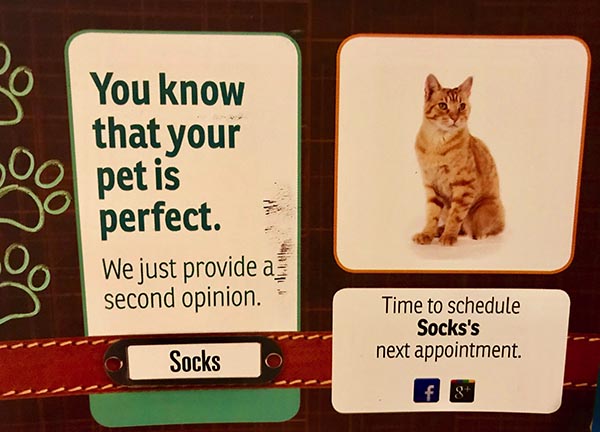Yesterday, I received a personalized postcard from our veterinarian. But it was another one of those examples of well-intentioned personalization that went somewhat wrong. It reminds us that if your client is going to make the additional investment in a personalized mailing, make sure they get it right.
The postcard was cute. It said, “You know that your pet is perfect. We just provide a second opinion.” There was a picture of an orange Tabby, with our cat’s name, Socks, underneath. There was also an invitation to make Socks’ next appointment. I stood there and stared at for while, not contemplating when to take Socks to the vet, but whether this attempt at personalization actually felt more personal to me or not.

Let’s look at my questions:
If they know my cat’s name, why didn’t they use my name in the copy? “Heidi, you know your pet is perfect.” Not that this would have made a difference. I get tired of seeing my name in large bold font when nothing else is relevant to me, so maybe it’s better that they didn’t. But it was a question.
Next, and more importantly, if they know my cat’s name, they should also know that she’s a Tuxedo cat (black-and-white), not a Tabby. Seeing a picture of a large Tabby with the name “Socks” underneath didn’t feel personal. It actually made me feel a bit uncomfortable. “That’s not my cat. Why does that strange, unfamiliar cat have my cat’s name on it?”
Let’s also go back to that cute message: “You know your pet is perfect.” They know I have a cat. Why didn’t they say, “You know your cat is perfect”?
Finally, and what may have stuck out to me the most, is that we have two cats, Socks and Cuddles. They are both Tuxedos. They are sisters. They go into the vet at the same time. So, does the vet only care about one cat and not the other? What’s up with that? (No, I didn’t receive two mailers—just the one.)
I love our veterinarian, so this isn’t to beat up on them. It’s a reminder that personalization is a critical tool in a marketing arsenal, but it has to be used well. Seeing a postcard with “We know your cat is perfect!” with a picture of a Tuxedo cat over the name “Socks” would certainly have drawn me in. As it was, I kept staring at that orange Tabby and thinking, “I don’t have an orange Tabby cat” and “What about our other cat?” I was so thrown off that I completely missed the CTA until later.
This isn’t just an intellectual exercise in picking apart a mailing. Spotting these things is critical for your print shop’s business, too. You are encouraging your clients to make an additional investment in personalized mailings. These mailings cost more, but they drive better results. So if the client’s conceptualization is poor and the results fall short of expectations, where will the client lay the blame? On the personalized piece? On you? When it comes to your long-term business and client relationships, awkward or ineffective personalization can be worse than none at all.
Encourage personalized communications, but make sure they are done right.










Discussion
By Gina Danner on Dec 11, 2018
Alas, the collision of operational data and marketing data. Unfortunately all too often when an organization tries VDP for the first time, or through a "packaged service" they miss the nuance required in creating and maintaining a "friendly" marketing data set.
The challenge is the data set started out for operational purposes and now must migrate to marketing messaging. No one analyzed the data and thought about it from the perspective of the "pet parent" or the "pets' family".
It's not unusual, but it happens. Often times the challenge is the PSPs involved in these projects often do little marketing on their own so they don't know that if the copy includes possession as in "'s" you must do a search for all the names that end in "s" and build logic to address those items.
And the fact that no on even thought about the "orange tabby" vs. the "black and white tuxedo" cat image -- or the "pet" vs "cat" item is just poor strategy.
VDP is a big win, but must be practiced with experienced professionals.
By Tod Cordill on Dec 11, 2018
Gina, I like the "operational data" vs "marketing data" concept. I've dealt with this issue but never used these terms.
They may have thought about the tabby-tuxedo issue but didn't have the time, resources or budget to address it. Good chance its written in a paper file but not in digital data. If this was the case better design would have been to use a more artistic and emotionally engaging cat image instead of a portrait.
Effective personalization is about being relevant, not showing off how much you know about something.
By Gina Danner on Dec 11, 2018
One challenge is that people still think "fill in the blank" in a single template, verses, using the right template then fill in the blank. Taking the step from the "name game" to the level of true highly personalized, purchase data, direct marketing can be a challenge and requires expertise and a broad vision.
By Patrick Whelan on Dec 12, 2018
Great article an even more enlightening comments.
Discussion
Join the discussion Sign In or Become a Member, doing so is simple and free